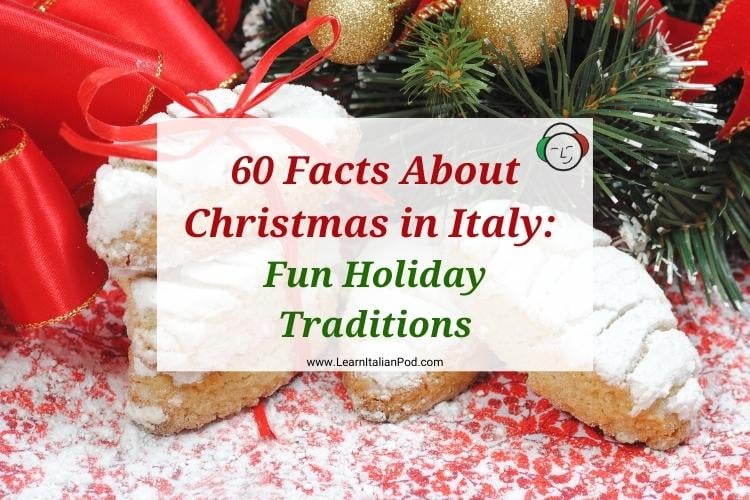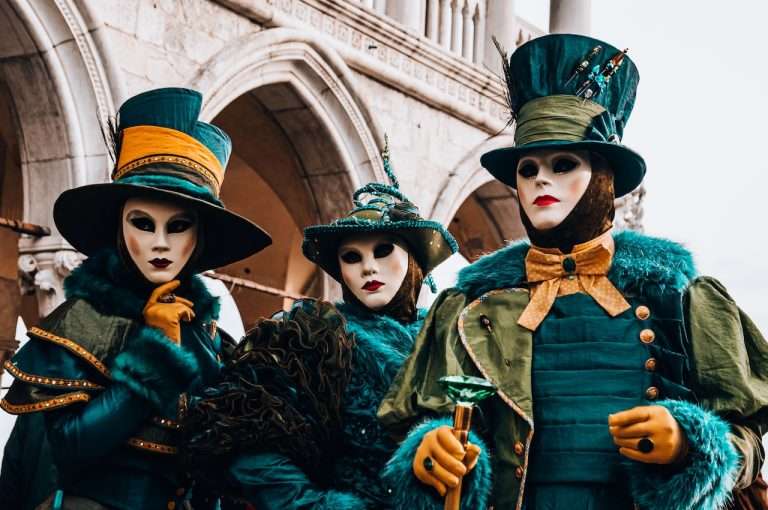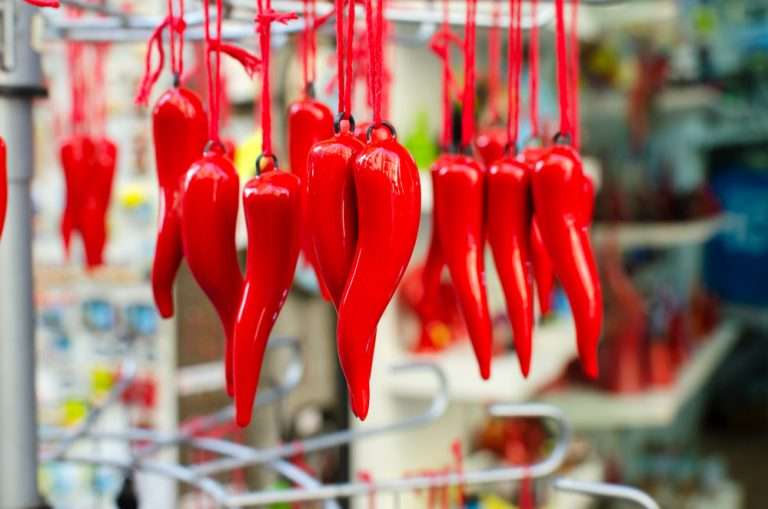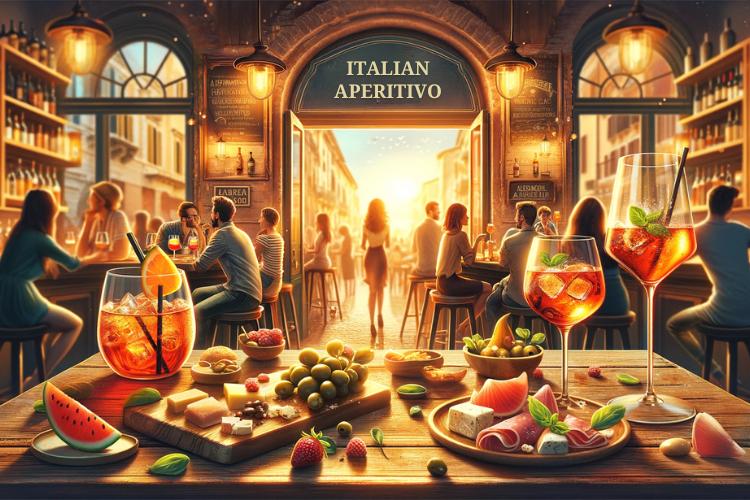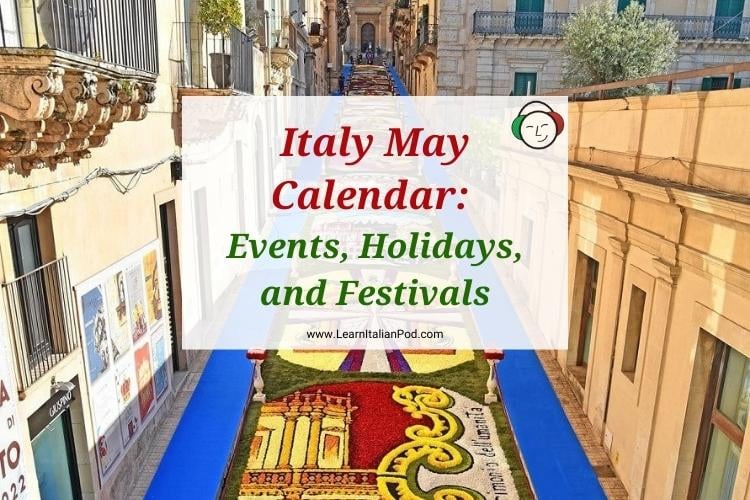60 Facts About Christmas in Italy: Fun Holiday Traditions
Hello everyone and Buon Natale! Welcome to our fascinating exploration of the facts about Christmas in Italy. Christmas, or Natale, is a joyous occasion of paramount importance in Italy, deeply woven into the country’s cultural fabric.
Italians are known for their love of tradition, family, and food – all of which shine brightly during the Christmas holidays.
In this article, we are thrilled to present 60 fun facts that make Christmas in Italy memorable. We’ve organized these facts into five categories for your reading pleasure:
- Christmas Timeline in Italy
- Italian Christmas Traditions
- Italian Christmas Food
- Christmas Eve and Day Activities
- New Year’s Traditions
Join us on this festive journey, and immerse yourself in the unique magic of Christmas in Italy.
Christmas Timeline in Italy
1. Christmas in Italy: A Month-Long Celebration
In Italy, Christmas isn’t merely a day; it’s an entire month of festivities and celebrations. Officially, the Christmas season starts on December 8th, with the Feast of the Immaculate Conception, and ends on January 6th, the Epiphany.
During this time, homes, streets, and squares are beautifully decorated, traditional markets spring up, and every corner of the country becomes a vibrant tableau of lights, colors, and joyous celebration.
Curious about Italy’s 2024 festivities? Dive into the vibrant celebrations and observances by exploring our Italy Calendar 2024.
2. The Feast of the Immaculate Conception
The Christmas season in Italy kicks off on December 8th with the Feast of the Immaculate Conception, a national holiday. This day celebrates the belief in the Immaculate Conception of the Virgin Mary.
It’s common for families to use this day to put up their Christmas decorations and nativity scenes. In Rome, the Pope visits the Piazza di Spagna to honor the Virgin Mary and bless a wreath placed on a statue dedicated to her.
3. Christmas Eve in Italy (La Vigilia di Natale)

Christmas Eve, or ‘La Vigilia di Natale,’ is a day filled with anticipation and preparations in Italy. Many Italians observe a partial fast, abstaining from meat, and then enjoy a feast of fish in the evening, known as the Feast of the Seven Fishes.
At midnight, many attend ‘La Messa di Mezzanotte‘ or Midnight Mass to celebrate the birth of baby Jesus. Some families also open gifts at midnight, symbolizing the end of waiting for the arrival of Jesus.
Suggested Read: Italian Blessings & Prayers: Unveiling Italy’s Spiritual Heritage.
4. Christmas Day in Italy (Il Giorno di Natale)
Christmas Day, ‘Il Giorno di Natale,’ is a day of celebration and family in Italy. It usually starts with a special breakfast that includes traditional sweets like ‘panettone’ and ‘pandoro.’ Then, families gather for ‘Il Pranzo di Natale,’ the grand Christmas lunch, which often lasts for hours and includes multiple courses.
The day is also marked by attending mass; in some regions, it’s when children receive gifts from Babbo Natale (Santa Claus). The day is filled with joy, laughter, and the warmth of togetherness.
Suggested Read: Why is Santa Called Babbo Natale in Italian?
5. Boxing Day in Italy (La Festa di Santo Stefano)
In Italy, the day after Christmas, known as Boxing Day in many countries, is celebrated as ‘La Festa di Santo Stefano.’ It’s a public holiday dedicated to St. Stephen, the first Christian martyr.
This is a day for Italians to relax and spend time with family after the grand Christmas festivities. Many Italians use the day to visit extended family or go out for a stroll, often to enjoy public concerts and performances in squares and parks across the country.
6. The Epiphany Feast (La Festa della Befana)

‘La Befana’ is a beloved Italian Christmas tradition that concludes the festive season on January 6th, the Epiphany.
According to folklore, La Befana is a good witch who flies on her broomstick on the night of January 5th to fill children’s stockings with candy and gifts if they’ve been good, or a lump of coal (usually a rock candy dyed black) if they’ve been naughty.
The figure of La Befana is so cherished in Italy that she even has her own dedicated holiday, known as ‘La Festa della Befana.’
Suggested Read: Italy January Calendar: Events, Festivals, and Holidays
7. Ski Week: La Settimana Bianca
‘La Settimana Bianca,’ literally ‘The White Week,’ is an Italian tradition. Families take a week-long holiday to ski resorts, usually between Christmas and the New Year or around the Epiphany.
With Italy’s stunning Alpine regions and the Apennines offering beautiful slopes and excellent winter sports facilities, it’s a unique opportunity for families to enjoy the winter landscapes, have fun skiing or snowboarding, and spend quality time together amidst the seasonal beauty.
Italian Christmas Traditions
1. Nativity Scenes in Italy (Il Presepe)

In Italy, the tradition of setting up ‘Il Presepe‘ or Nativity Scene is as crucial as decorating a Christmas tree. These beautiful and intricate displays depict the birth of Jesus Christ in Bethlehem.
They often include figurines of the Holy Family, the Three Wise Men, shepherds, animals, and angels, set within a stable or cave. Many Italian families have heirloom presepi that have been passed down through generations, each piece carrying a story of its own.
2. The Oldest Nativity Scene in the World
Italy is home to the oldest known Nativity scene in the world, located in the Basilica of Santa Maria Maggiore in Rome. This marvelous ancient wooden tableau dates back to the 13th century and was carved by Arnolfo di Cambio, a famous Italian sculptor and architect.
It’s a testament to the long-standing tradition of ‘Il Presepe‘ in Italian culture, and it continues to captivate visitors with its age-old charm.
Planning to go to Italy? Discover the safest Italian cities for a worry-free trip.
3. The Living Nativities (I Presepi Viventi)
Another unique Italian Christmas tradition is ‘I Presepi Viventi‘ or Living Nativities. In towns and villages across Italy, locals reenact the nativity scene in real-time, donning biblical attire and portraying the characters from the holy night.
Many of these performances occur in historical settings, adding to the authenticity and atmosphere. It’s a truly immersive experience, allowing viewers to step back in time and experience the first Christmas.
4. The Christmas Tree (L’Albero di Natale)

Like many other countries, Italy celebrates Christmas time by decorating ‘L’Albero di Natale‘ or the Christmas Tree. Italian families usually put up their tree and start decorating it on December 8th, the Day of Immaculate Conception.
The tree is adorned with lights, Christmas ornaments, and tinsel and is often topped with a star to represent the Star of Bethlehem.
Suggested Read: Five Italian Christmas Trees that will add some serious holiday cheer to your Christmas.
5. The World’s Largest Christmas Tree

Italy boasts the world’s largest Christmas tree, but it’s not a tree in the traditional sense. Every year, on the slopes of Mount Ingino in Gubbio, Umbria, a gigantic ‘tree’ is outlined using hundreds of colorful lights.
The ‘tree’ is over 650 meters high and can be seen from miles away. This incredible spectacle, known as the ‘Albero di Natale di Gubbio,’ has been lighting up the Umbrian hills every Christmas season since 1981.
6. Santa Claus in Italian (Babbo Natale)
In Italy, Santa Claus is known as ‘Babbo Natale,’ which translates to ‘Father Christmas.’ Just like his counterparts worldwide, Babbo Natale wears a red suit and hat, sports a white beard, and carries a sack filled with gifts.
Children write letters to him, listing their holiday wishes. Depending on regional customs, Babbo Natale delivers gifts either on Christmas Eve or Christmas Day, filling the holiday season with joy and anticipation for Italian children.
7. How to Say Merry Christmas in Italian (Buon Natale)

The festive season brings warm greetings; if you’re in Italy, you’d say, “Buon Natale!” This is the Italian way of saying “Merry Christmas!” It’s a phrase you’ll hear everywhere, from the bustling city streets to the quiet country villages, as people spread the joy and goodwill of the season.
8. The Letter to Santa Claus (La Lettera a Babbo Natale)
Just like children all around the world, Italian kids also write letters to Santa Claus, or ‘La Lettera a Babbo Natale.’ They pen their wishes and hopes for the gifts they’d like to receive.
These heartfelt, handwritten notes are often sent in the mail, but some children prefer to leave them out on Christmas Eve, hoping that Babbo Natale will read them when he comes with his gifts.
9. Opening Christmas Gifts (Aprire i Regali di Natale)
The tradition of ‘Aprire i Regali di Natale’ or Opening Christmas Gifts varies across Italy. Some families exchange gifts on Christmas Eve, symbolizing the end of waiting for the arrival of baby Jesus.
Others wait until Christmas Day, often after attending mass in the morning. In some regions, gifts are opened on January 6th, the day of the Epiphany, when La Befana brings gifts for the children.
Searching for the ideal Italian-themed gift? Look no further! Our Italian gifts guide is here to help you find the perfect present.
10. St. Nicholas Opening Gift Day
In some parts of Northern Italy, particularly in Trentino and South Tyrol, children receive gifts from Saint Nicholas on December 6th. Saint Nicholas, a 4th-century bishop known for his generous deeds, is a precursor to the modern Santa Claus.
On this day, children leave their shoes out the night before and wake up to find them filled with treats and small gifts if they’ve been good or a lump of coal if they’ve been naughty.
11. Santa Lucia Opening Gift Day
In some areas of Italy, particularly the north, Santa Lucia, a 3rd-century martyr, brings gifts for children on December 13th, her feast day.
Children leave out their shoes or a special basket, and Santa Lucia leaves gifts and sweets for those who have been good. Children eagerly anticipate this day with a family feast and memorable songs.
12. Opening Gifts on Christmas Eve/Christmas Day

While traditions can vary in different parts of Italy, many families open their gifts either on Christmas Eve or Christmas Day. The excitement of ‘Aprire i Regali di Natale‘ (Opening Christmas Gifts) is a cherished moment, bringing families together in shared joy and gratitude.
13. La Befana Opening Gift Day
The Epiphany on January 6th is when La Befana, the benevolent witch, visits. According to Italian folklore, La Befana flies on her broomstick to deliver gifts to good children and coal to those who have been naughty.
The morning of January 6th is filled with excitement as children wake up to discover what La Befana has left for them.
14. Most Popular Christmas Gifts in Italy
Italian Christmas gifts reflect the country’s rich culture and traditions. Popular gifts include artisanal products such as Italian leather goods, traditional foods like Panettone and Torrone, fine wines, and high-quality espresso machines.
Toys and books are commonly gifted to children, while jewelry and fashion items are popular among adults.
Find the Perfect Italian Gift: Check out our resources to discover the ideal gift for someone who adores Italy.
15. Christmas Carols (I Canti di Natale)
Italy, renowned as the birthplace of the Christmas carol, is imbued with a musical spirit during the holiday season. The tradition, believed to have been introduced by St. Francis of Assisi, features simple, joyful songs known as ‘I Canti di Natale‘ that celebrate the birth of Christ.
These melodious carols, including favorites like ‘Tu Scendi dalle Stelle‘ (‘You Come Down from the Stars’) and ‘Astro del Ciel (‘Silent Night’), resonate in homes, churches, and along bustling streets. Beyond the confines of formal church hymns, these carols serve as a ubiquitous expression of joy, their warm notes fostering a festive atmosphere throughout the holiday season.
16. The Bagpipe Players (Gli Zampognari)
In southern Italy and Rome, ‘Gli Zampognari‘ or bagpipe players are a significant part of the Christmas tradition.
Dressed in sheepskin and woolen cloaks, these musicians play traditional carols on their bagpipes and flutes, often in front of Nativity scenes or during processions, lending a unique sound to the Italian Christmas celebrations.
15. Christmas Lights Everywhere

Come the Christmas season, Italy transforms into a twinkling wonderland. ‘Luminarie,’ or Christmas lights, adorn streets, squares, and buildings, casting a magical glow over cities and villages alike.
From the grand illuminations of Rome and Milan to the charming light displays in smaller towns, the festive lights are a sight to behold and an integral part of Italy’s Christmas charm.
18. Italian Christmas Markets
Italian Christmas Markets bring a dash of festive magic to cities across Italy, offering a treasure trove of artisanal gifts, local delicacies, and charming holiday decorations.
One notable example is the Christmas market in Piazza Navona, Rome. This vibrant market, open from late November to early January, is a popular destination for both locals and tourists and an enchanting part of Rome’s Christmas celebrations.
19. Christmas Sales (I Saldi di Natale)
Italy’s vibrant Christmas markets and seasonal sales are a shopper’s delight. From artisan crafts and gourmet food products to fashion items and toys, the Christmas sales (in Italian, “saldi di Natale”) offer a wide array of potential gifts.
Many Italians look forward to these sales as an opportunity to find unique presents and indulge in the joy of holiday shopping.
Recommended Read: Top 10 shopping destinations in Italy: a guide from luxury fashion to artisanal crafts.
20. The Lump of Coal (Il Pezzo di Carbone)
In Italian tradition, misbehaving children might receive ‘Il Pezzo di Carbone,’ or a lump of coal, instead of gifts. Today, this ‘coal’ is usually a sweet treat made from sugar and food coloring, serving more as a gentle, playful reminder of good behavior than a punishment.
21. The Yule Log (Il Ceppo di Natale)
Like other European cultures, some Italian families celebrate Christmas with ‘Il Ceppo di Natale‘ or the Yule Log. This involves choosing a large log, often oak, which is lit on Christmas Eve.
It’s meant to burn slowly through the night, symbolizing warmth and light and bringing good luck for the coming year. It also serves as a gathering spot for family storytelling and sharing.
22. The Shooting Star in Verona

A massive white iron star graces the Arena di Verona every year, symbolizing the celestial guide that led the Three Wise Men to Jesus. This ancient Roman amphitheater, even older than Rome’s Colosseum, becomes the backdrop for this stunning spectacle.
Since its inception in 1984, this 70-meter high, 78-ton structure has become integral to Verona’s Christmas traditions. Placed in Piazza Bra annually, the star’s grandeur and historical significance contribute to the unique Christmas atmosphere in this Italian city.
23. The Urn of Fate
An exciting part of Italian Christmas is the ‘Urn of Fate.’ It contains wrapped gifts for each family member, and everyone draws a present from the urn.
This tradition, which often takes place after Christmas dinner, adds an element of surprise and anticipation to the festivities, with the urn’s contents often a secret until the moment of unwrapping.
24. Santa Lucia’s Dish (Il Piatto di Santa Lucia)
In some regions, children prepare ‘Il Piatto di Santa Lucia‘ on the eve of December 13th. This dish, filled with carrots, hay, and other treats, is left out for Santa Lucia’s donkey.
It’s a charming tradition that builds excitement for Santa Lucia’s visit and encourages generosity and caring for animals.
25. Santa Claus Runs
In many Italian cities, ‘Santa Claus Runs‘ or ‘Corsa di Babbi Natale’ are organized, where participants dress up as Santa and run a short race. It’s a joyous event that brings communities together and adds a fun, active element to the holiday season. Both children and adults participate, often raising money for charitable causes.
26. The Venice Christmas Regatta
Every year, Venice hosts a unique event – the Christmas Regatta. Participants row in traditional Venetian boats dressed as Santa Claus, making for a delightful spectacle against the city’s picturesque waterways.
The event attracts locals and tourists alike, infusing Venice’s holiday season with a uniquely aquatic charm.
27. The Befana Regatta in Venice

Following the festive Christmas Regatta, Venetians seize another opportunity to showcase their boating prowess on Epiphany Day, January 6th.
This spectacle, known as the Befana Regatta, features 50 athletes from Venice’s historic “Bucintoro” rowing club. Donning old witch disguises, they engage in a thrilling race from San Tomà to the iconic Rialto Bridge.
The climax of the race is a massive sock dangling from the Rialto Bridge, serving as the finish line. This fun tradition adds another layer of charm to Venice’s holiday season, captivating both residents and visitors.
28. The Befana’s Bonfire (Il Falò della Befana)
Il falò della Befana, or the Befana’s bonfire, is another cherished tradition associated with the old lady Befana. In many Italian communities, a bonfire is lit on the evening of January 6th to bid farewell to the Christmas season. It is a symbolic way to ‘burn away’ the old year and welcome the new.
29. La Tredicesima (Christmas Bonuses)
La Tredicesima, or the thirteenth, refers to the tradition of employers providing a Christmas bonus to their employees. This bonus, typically equivalent to a month’s salary, is given to bring joy and financial relief during the holiday season. It’s an appreciated practice that fosters goodwill between employers and employees.
30. Ice Skating in Italy at Christmas
Ice skating is a popular pastime in Italy during the Christmas season. Many Italian cities set up temporary ice rinks in public squares, allowing locals and tourists alike to glide across the ice under twinkling holiday lights. It’s a festive activity that adds a sense of winter wonder to the Italian Christmas experience.
Italian Christmas Food
1. Italians Don’t Eat Meat on Christmas Eve
In Italy, it’s customary to abstain from meat on Christmas Eve. This tradition, known as ‘La Vigilia,’ is a form of symbolic fasting before the grand feast on Christmas Day.
On the evening of December 24th, the meal typically consists of various fish dishes and vegetables, making it a unique aspect of Italian Christmas celebrations.
2. The Feast of The Seven Fishes

The tradition of ‘La Cena della Vigilia,’ also known as the Feast of the Seven Fishes, is a cherished part of Italian-American Christmas Eve celebrations.
This sumptuous seafood banquet, featuring seven different types of fish, embodies the seven sacraments of the Catholic Church. Each component is meticulously crafted, contributing to a luxurious dining experience that’s anticipated with much excitement.
Although the term “Seven Fishes” isn’t typically used in Italy, the custom is rooted in the experiences of 20th-century Italian-American immigrants.
These immigrants longed for their homeland and combined traditional Italian recipes with various seafood to symbolize the bond between their old and new homes.
The assortment of seafood used in this feast can vary based on regional preferences. Still, it often includes a range of delectable choices such as crab, shrimp, calamari, clams, mussels, scallops, lobster, and white fish.
3. Traditional Christmas Food: Panettone

Panettone, a tall, dome-shaped sweet bread filled with candied fruits and raisins, is a staple during Italian Christmas. Originating from Milan, this fluffy delight is enjoyed at the end of the Christmas meal or for breakfast, often accompanied by sweet wine or hot chocolate.
4. Traditional Christmas Food: Pandoro
Pandoro, meaning ‘golden bread,’ is another traditional Christmas cake from Verona. Unlike Panettone, Pandoro is star-shaped, without fruits or nuts, and dusted with powdered sugar. The golden color, sweet flavor, and light texture make it a favorite holiday dessert.
5. Traditional Christmas Food: Panpepato
Panpepato is a dense, spicy cake that originates from Ferrara in the Emilia-Romagna region. Filled with almonds, hazelnuts, candied citrus peel, cocoa, and various spices, it’s a rich and warming treat that’s especially popular during Christmas.
6. Traditional Christmas Food: Torrone
Torrone is a traditional nougat made with honey, egg whites, and toasted nuts. There are many regional variations, some soft and chewy, others hard and crunchy. Wrapped in edible rice paper, Torrone is a sweet treat enjoyed throughout the Christmas season.
7. Traditional Christmas Food: Panforte

Panforte is a chewy dessert from Siena, Tuscany. It contains fruits, nuts, spices, and honey, resulting in a dense, rich cake often enjoyed with coffee or a glass of dessert wine. Its name means ‘strong bread,’ referring to its robust flavor.
8. Traditional Christmas Food: Chestnuts
Chestnuts are a beloved winter treat in Italy. During Christmas, you’ll often find vendors roasting chestnuts on street corners, filling the air with a warm, nutty aroma. These sweet and hearty nuts are often enjoyed straight from the fire while strolling through Christmas markets.
9. Il Vin Brule (Mulled Wine)

Il Vin Brule, or mulled wine, is popular during the Italian Christmas season. It’s a warming beverage that adds a festive note to cold winter nights, made by heating red wine with spices such as cloves, cinnamon, and nutmeg and sweetened with sugar.
Suggested Read: 12 Italian Christmas Drinks: Festive Cocktails from Italy.
10. The Christmas Food Drives
In the spirit of giving, many Italians participate in Christmas food drives. These charitable efforts involve donating food items to those in need, ensuring everyone can enjoy a hearty meal during the holiday season. It’s a tradition emphasizing the importance of generosity and community during Christmas in Italy.
Christmas Eve and Day Activities in Italy
1. La Messa di Mezzanotte (The Midnight Mass)
La Messa di Mezzanotte, or the Midnight Mass, is a deeply cherished tradition in Italy, marking the official start of Christmas.
Held on the night of Christmas Eve, the mass symbolizes the birth of Jesus Christ. Churches across Italy, from the smallest village churches to grand cathedrals, are filled with worshippers who come to celebrate and reflect.
2. Christmas Lunch in Italy (Il Pranzo di Natale)

Il Pranzo di Natale, the Christmas Lunch, is a significant event in Italian households. This lengthy feast, often lasting several hours, brings together families over an array of traditional dishes. Every course celebrates Italian culinary traditions, from antipasti to desserts like Panettone and Pandoro.
3. Christmas Day in the Vatican

Christmas Day in the Vatican City is a truly unforgettable experience. Pilgrims from around the world gather in St. Peter’s Square for the Pope’s annual Christmas message, ‘Urbi et Orbi‘ (To the City and the World). This heartfelt message of peace and goodwill resonates deeply during the festive season.
4. Christmas Holy Mass at the Vatican
The Christmas Holy Mass at the Vatican is a solemn, sacred event. Held in the magnificent St. Peter’s Basilica, the mass is celebrated by the Pope and attended by thousands of worshippers. Adorned with lights and decorations, the Basilica provides a grand, spiritual backdrop to this sacred celebration.
5. Christmas Concerts in Italy
Christmas concerts are a highlight of the Italian festive season. From classical music and traditional carols to modern renditions, these concerts occur in various venues, including churches, theatres, and town squares. They’re a fantastic way to soak in the festive spirit and appreciate Italy’s rich musical heritage.
6. Christmas Family Get Togethers
In Italy, Christmas is a time for family. Extended family members come together to celebrate, share meals, exchange gifts, and enjoy each other’s company. These gatherings, marked by laughter, love, and warmth, are at the heart of Italian Christmas celebrations.
7. The Christmas Day Nap

The Afternoon Nap, or ‘Il Pisolino,’ is an endearing Italian Christmas Day tradition that perfectly complements the lavish lunch feast. After indulging in the grand ‘Il Pranzo di Natale‘, Italians take a leisurely, restorative nap to relax and aid digestion.
This delightful custom is not just about physical rejuvenation but also about savoring the tranquility of the holiday and recharging for the festivities yet to come.
In Italian homes, the Christmas Day nap is an art form, a testament to the Italian love for life’s simple pleasures.
8. Sending Christmas Cards
Even though the tradition of sending Christmas cards, known as ‘biglietti di Natale,’ is less widespread in Italy than in other countries, a number of Italians do partake in this custom.
These cards, typically adorned with nativity scenes or various festive illustrations, offer a considerate means of expressing Christmas sentiments and extending good wishes for the upcoming year.
Suggested Reading: Italian Christmas Quiz: Test Your Festive Trivia IQ
Italy’s New Year’s Traditions
1. New Year’s Eve in Italy (La Notte di Capodanno)
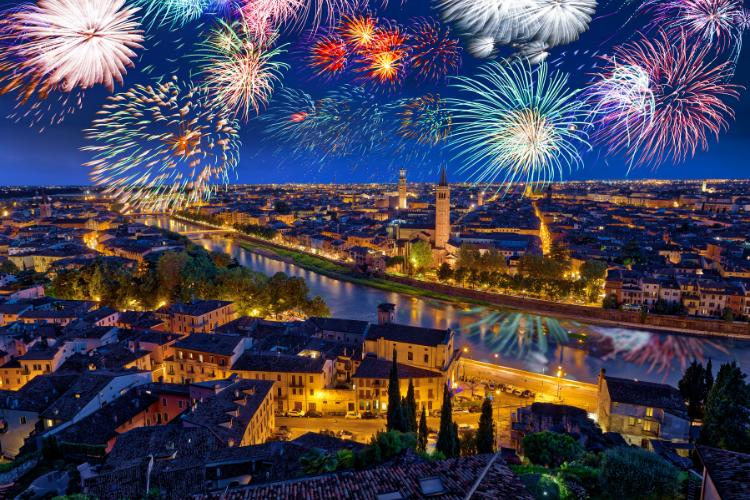
La Notte di Capodanno, or New Year’s Eve in Italy, is a vibrant celebration filled with food, fireworks, and festivities.
The evening often kicks off with a lavish feast known as ‘Cenone,’ followed by parties that last until dawn. At midnight, fireworks light up the sky, marking the arrival of the New Year.
2. New Year’s Eve Bonfire (Il Falò di Capodanno)
Il Falò di Capodanno, or New Year’s Eve Bonfire, is a tradition in some parts of Italy. Large bonfires are lit in public squares, symbolizing the burning away of the old year’s troubles and welcoming new beginnings. The glow of the fire creates a warm and communal atmosphere.
3. Throw Old Things from the Window on New Year’s Eve
This quirky tradition involves Italians throwing old items out of their windows on New Year’s Eve. Symbolizing the release of past worries and the welcoming of new possibilities, this ritual adds a touch of fun and excitement to the festivities. However, it’s less common today due to safety considerations.
4. The Red Underwear Tradition on New Year’s Eve

Adding a dash of color to their New Year’s Eve attire, Italians follow the whimsical tradition of donning red underwear as they bid farewell to the old year. Yes, you read that right! This quirky custom, steeped in folklore, is believed to bring luck, love, and prosperity in the coming year.
So, if you find yourself celebrating Capodanno (New Year’s Eve) in Italy, remember to wear your most festive crimson undergarments. After all, when in Rome, do as the Romans do – down to your skivvies!
5. Let’s Play Bingo (La Tombola) or Cards (Le Carte)
La Tombola is a popular game similar to Bingo, often played during the holiday season in Italy. Family and friends gather around, each with a ‘cartella‘ (game card) in hand, hoping their numbers will be called out. It’s a fun, friendly activity that spans all ages.
Playing cards, or ‘Giocare a Carte,’ is a beloved pastime in Italy, particularly during the holiday season. Italian card games like ‘Scopa‘ and ‘Briscola’ become common at family gatherings, fostering camaraderie and friendly competition as everyone rings in the New Year.
As we conclude our festive journey through Christmas in Italy, it’s clear that this holiday holds a special place in the heart of Italian culture. The rich traditions, delightful food, and festive activities create a magical time of year.
We hope these 60 facts have given you a deeper insight into Italian Christmas celebrations and perhaps even inspired you to incorporate some Italian traditions into your festivities.
Christmas in Italy is a heartfelt and memorable affair, from the month-long celebrations to the delicious feasts and warm family gatherings. Buon Natale, and a Happy New Year to you all!
Further Reading:

